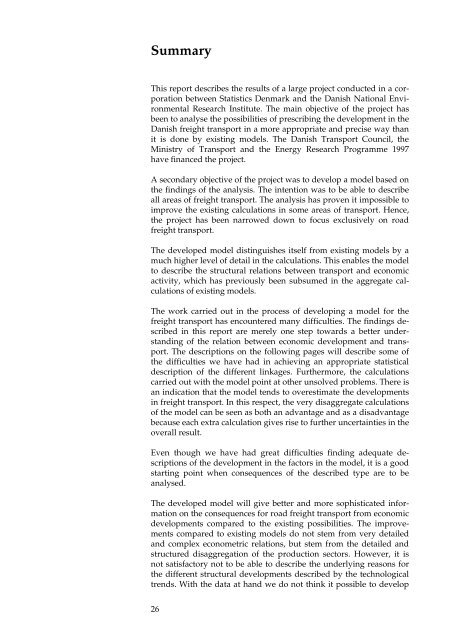En model for godstransportens udvikling - DCE - Nationalt Center for ...
En model for godstransportens udvikling - DCE - Nationalt Center for ...
En model for godstransportens udvikling - DCE - Nationalt Center for ...
Create successful ePaper yourself
Turn your PDF publications into a flip-book with our unique Google optimized e-Paper software.
Summary<br />
This report describes the results of a large project conducted in a corporation<br />
between Statistics Denmark and the Danish National <strong>En</strong>vironmental<br />
Research Institute. The main objective of the project has<br />
been to analyse the possibilities of prescribing the development in the<br />
Danish freight transport in a more appropriate and precise way than<br />
it is done by existing <strong>model</strong>s. The Danish Transport Council, the<br />
Ministry of Transport and the <strong>En</strong>ergy Research Programme 1997<br />
have financed the project.<br />
A secondary objective of the project was to develop a <strong>model</strong> based on<br />
the findings of the analysis. The intention was to be able to describe<br />
all areas of freight transport. The analysis has proven it impossible to<br />
improve the existing calculations in some areas of transport. Hence,<br />
the project has been narrowed down to focus exclusively on road<br />
freight transport.<br />
The developed <strong>model</strong> distinguishes itself from existing <strong>model</strong>s by a<br />
much higher level of detail in the calculations. This enables the <strong>model</strong><br />
to describe the structural relations between transport and economic<br />
activity, which has previously been subsumed in the aggregate calculations<br />
of existing <strong>model</strong>s.<br />
The work carried out in the process of developing a <strong>model</strong> <strong>for</strong> the<br />
freight transport has encountered many difficulties. The findings described<br />
in this report are merely one step towards a better understanding<br />
of the relation between economic development and transport.<br />
The descriptions on the following pages will describe some of<br />
the difficulties we have had in achieving an appropriate statistical<br />
description of the different linkages. Furthermore, the calculations<br />
carried out with the <strong>model</strong> point at other unsolved problems. There is<br />
an indication that the <strong>model</strong> tends to overestimate the developments<br />
in freight transport. In this respect, the very disaggregate calculations<br />
of the <strong>model</strong> can be seen as both an advantage and as a disadvantage<br />
because each extra calculation gives rise to further uncertainties in the<br />
overall result.<br />
Even though we have had great difficulties finding adequate descriptions<br />
of the development in the factors in the <strong>model</strong>, it is a good<br />
starting point when consequences of the described type are to be<br />
analysed.<br />
The developed <strong>model</strong> will give better and more sophisticated in<strong>for</strong>mation<br />
on the consequences <strong>for</strong> road freight transport from economic<br />
developments compared to the existing possibilities. The improvements<br />
compared to existing <strong>model</strong>s do not stem from very detailed<br />
and complex econometric relations, but stem from the detailed and<br />
structured disaggregation of the production sectors. However, it is<br />
not satisfactory not to be able to describe the underlying reasons <strong>for</strong><br />
the different structural developments described by the technological<br />
trends. With the data at hand we do not think it possible to develop<br />
26

















